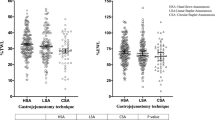Background: Gastro-gastric fistulas and marginal ulcers are frequent and serious complications of gastric compartmentalization procedures for obesity. Methods: The authors analyzed 810 patients after 911 operations for gastro-gastric fistulas and marginal ulcers over an 8-year period. All patients underwent a form of gastric bypass, in which a pouch is constructed along the lesser curvature of the stomach. The outlet of the pouch was restricted with a prosthetic band. In the first 189 patients (Group I), the pouch and stomach were stapled in continuity or partially divided. In the next 222 patients (Group II), segments were stapled and separated by transection. In the remaining 492 cases (Group III), in addition to transection of the stomach, a limb of jejunum was interposed between the pouch and excluded stomach. Stapled anastomoses were done in Group I and II patients and a portion of Group III patients. The remaining patients underwent hand-sewn anastomosis. Results: Gastro-gastric fistulas occurred in 49% of the patients in Group I, 2.6% of those in Group II, and 0% of those in Group III. In stapled anastomosis, the incidence of marginal ulceration in Groups I, II, and III were 8.5%, 5.4%, and 5.1%, respectively. In a subset of Group III patients, in whom a two-layer, hand-sewn anastomosis was done, the incidence was 1.6% when the outer layer was not absorbable and 0% when both layers were absorbable. Conclusions: Gastro-gastric fistulas and marginal ulcerations are likely the result of breakdown of the mucosa resulting from migrating staples and other foreign material. Lack of integrity of the gastric lining facilitates the action of the gastric digestive process. Transection of gastric segments with interposition of jejunum prevents gastro-gastric fistula formation. An intact serosa appears to block the digestion of bowel wall by gastric enzymes. Our early data suggest that the use of absorbable sutures at the gastrojejunostomy significantly decreases the incidence of marginal ulceration.
Similar content being viewed by others
Author information
Authors and Affiliations
Rights and permissions
About this article
Cite this article
Capella, J.F., Capella, R.F. Gastro-Gastric Fistulas and Marginal Ulcers in Gastric Bypass Procedures for Weight Reduction. OBES SURG 9, 22–27 (1999). https://doi.org/10.1381/096089299765553674
Published:
Issue Date:
DOI: https://doi.org/10.1381/096089299765553674




